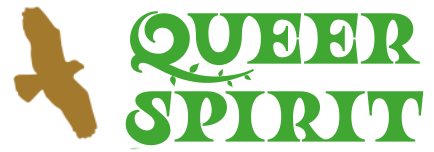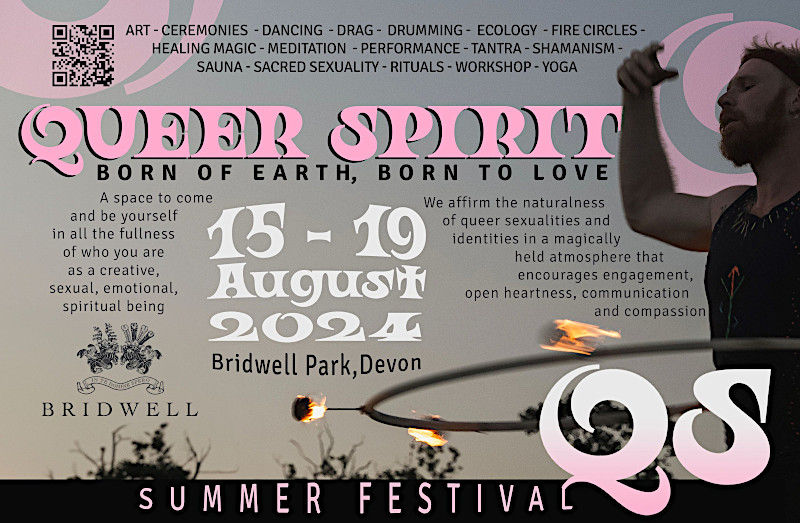Wishing everybody a blessed Imbolc!
The Celtic Fire festival of Imbolc (February 1st) celebrates the promise of Spring, just a few weeks away. Imbolc is a powerful moment to perform acts of divination, eg draw tarot cards, cast runes... in order to receive guidance from the subtle realms, and the time to set goals and intentions for the upcoming seasons. We hope you will be setting the goal of coming to Queer Spirit and inviting more people along!
The Queer Spirit Team are delighted to inform you that, as Imbolc arrives, planning for the 5th Queer Spirit Festival is well underway. Rising Spirit tickets have sold out! The programme of workshops and ceremonies is taking shape and will be announced soon. Performers are signing up, and this year there are more queer community groups coming along to join the fun.
We hope you will be joining us at the beautiful Bridwell Park, Devon, 15-19 August – and if you have enjoyed Queer Spirit previously we are also hoping that you will help us to spread news of the festival to your friends, to individuals and groups who might be interested to come along. The organising team is cooking up a magical cauldron of experiences, but the magic of Queer Spirit comes equally from the creativity and attitudes of the attendees: Let's make Queer Spirit 2024 the most amazing, joy-filled, healing and holistic festival yet!
PLEASE HELP US SPREAD THE WORD BY INVITING PEOPLE ALONG!
IMBOLC
is the Celtic festival of the Maiden Goddess Brigit/Bride/Bridie – whose name appears in Bridwell Park, Queer Spirit's wonderful new home, where her sacred healing springs are still flowing on the land. Imbolc is a fire festival and is a good time to symbolically light our own inner fire, to invoke our own inner Goddess (whatever our biological sex and sense of gender identity) – this is a powerful moment to attune ourselves to the Earth's natural cycles and dedicate ourselves to our personal healing and growth.
A largely missing part in the modern liberation story of LGBTQ+ people is our historical association with Goddess worship. The modern Gay Liberation movement emerged in a secular age, when religious questions were pushed aside, ignored, ridiculed. But those questions just won't go away. Religious texts are still used to justify persecution of queer people around the world – and the fact is that virulent religious homophobia, for example in Africa, is a legacy of the European colonial age. Until the original cause of Judaeo-Christian homophobia is properly exposed and uprooted the prejudice will not end. It needs queer people to do this, nobody is going to do it for us!
Over a century ago there were some queers already calling for this emancipation: John Addington Symonds wrote in his 1891 work, 'A Problem in Modern Ethics':
“…it is of the highest importance to obtain a correct conception of the steps whereby the Christian nations, separating themselves from ancient paganism, introduced a new and stringent morality into their opinion on this topic, and enforced their ethical views by legal prohibitions of a very formidable kind.”
19th century British explorer Richard Frances Burton wrote, -
“The Hebrews entering Syria, found it religionised by Assyria and Babylonia, when the Accadian Ishtar had passed West, and had become Ashtoreth, Ashtaroth, or Ashirah, the Anaitis of Armenia, the Phœnician Astarte, and the Greek Aphrodite, the great Moon-goddess who is queen of Heaven and Love. . . . She was worshipped by men habited as women, and vice versa; for which reason, in the Torah (Deut. xxii. 5), the sexes are forbidden to change dress.”
Edward Westermarck’s 1906 book 'The Origin and Development of Moral Ideas' included a chapter presenting an overview of the occurrence of homosexuality and gender fluidity around the world. He wrote that:
“…the Hebrew’s abhorrence of sodomy was largely due to their hatred of a foreign cult. According to Genesis, unnatural vice was the sin of a people who were not the Lord’s people…. we know sodomy entered as an element in their religion. Besides kedeshoth, or female prostitutes, there were kedeshim, or male prostitutes, attached to their temples. The word Kadesh, translated ‘sodomite’, properly denotes a man dedicated to a deity; and it appears that such men were consecrated to the mother of the gods, the famous Dea Syria, whose priests or devotees they were considered to be…. the sodomitic acts committed with these temple prostitutes may, like the connections with priestesses, have had in view to transfer blessings to the worshippers.”
Pagan cultures considered the body, and sexuality, to be holy. Pre-Christian cultures in Europe and around the world accepted gay sex as entirely natural.
Historical research reveals that gender-fluid and same-sex loving people often played spiritual roles in communities that honoured the Divine Feminine, that respected the Earth, the body and therefore all human beings as children of the Goddess.
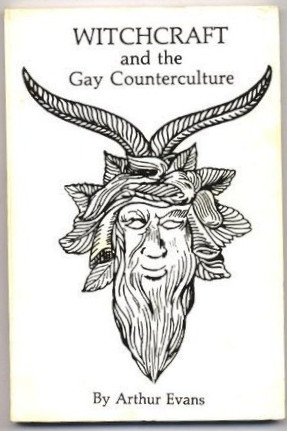 “…the ritual worship of sex and nature was once the case throughout the world... In these societies, as in the case of the witches, women and Gay men generally enjoyed a high status, Gay people of both sexes were looked upon with religious awe, and sexual acts of every possible kind were associated with the most holy forms of religious expression. Admittedly, there were also great diversities and variations in the beliefs and practices of these societies, but there was one great common feature that set them off in sharp distinction to the Christian/industrial tradition: their love of sexuality…” Arthur Evans, Witchcraft and the Gay Counter-Culture, 1978
“…the ritual worship of sex and nature was once the case throughout the world... In these societies, as in the case of the witches, women and Gay men generally enjoyed a high status, Gay people of both sexes were looked upon with religious awe, and sexual acts of every possible kind were associated with the most holy forms of religious expression. Admittedly, there were also great diversities and variations in the beliefs and practices of these societies, but there was one great common feature that set them off in sharp distinction to the Christian/industrial tradition: their love of sexuality…” Arthur Evans, Witchcraft and the Gay Counter-Culture, 1978
This IMBOLC let's take a moment to take this in:
“At the time of the birth of Christ, cults of men devoted to a goddess flourished throughout the broad region extending from the Mediterranean to south Asia. While galli were missionizing the Roman Empire, kalu, kurgarru, and assinnu continued to carry out ancient rites in the temples of Mesopotamia, and the third-gender predecessors of the hijra were clearly evident in lndia. To complete the picture we should also mention the megabyzoi, or eunuch priests of Artemis at Ephesus; the western Semitic qedesha, the male “temple prostitutes” known from the Hebrew Bible and Ugaritic texts of the late second millennium; and the keleb, priests of Astarte at Kition and elsewhere… These roles share the traits of devotion to a goddess, gender transgression and homosexuality, ecstatic ritual techniques (for healing, in the case of galli and Mesopotamian priests, and fertility, in the case of hijra), and actual (or symbolic] castration. Most, at, some point in their history, were based in temples and, therefore, part of the religious-economic administration of their respective city-states.” Will Roscoe
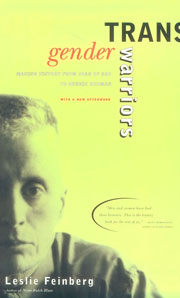 “I discovered abundant evidence of male-to-female transsexual women priestesses who played an important role in the worship of the Great Mother... The Great Mother was emblematic of pre-class communalism... While it's impossible today to interpret precisely how people who lived millennia ago viewed this goddess, Roman historian Plutarch described the Great Mother as an intersexual (hermaphroditic) deity in whom the sexes had not yet been split... Many Mediterranean, Middle Eastern and near Eastern goddesses were served by transsexual priestesses, including the Syrian Astarte and Dea Syria at Hierapolis, Artemis, Atargatis, Ashtoreth or Ishtar, Hecate at Laguire, and Artemis (Diana) at Ephesus.” Leslie Feinberg, Transgender Warriors
“I discovered abundant evidence of male-to-female transsexual women priestesses who played an important role in the worship of the Great Mother... The Great Mother was emblematic of pre-class communalism... While it's impossible today to interpret precisely how people who lived millennia ago viewed this goddess, Roman historian Plutarch described the Great Mother as an intersexual (hermaphroditic) deity in whom the sexes had not yet been split... Many Mediterranean, Middle Eastern and near Eastern goddesses were served by transsexual priestesses, including the Syrian Astarte and Dea Syria at Hierapolis, Artemis, Atargatis, Ashtoreth or Ishtar, Hecate at Laguire, and Artemis (Diana) at Ephesus.” Leslie Feinberg, Transgender Warriors
Over a century ago, in his book, ‘Intermediate Types Among Primitive Folks’ (1911), gay philosopher Edward Carpenter identified roles that many cultures long reserved for homo- or transsexual people: “the priest, medicine-man or shaman, the prophet and the diviner, the artist and craftsperson and the true scientist, successor to the tribal observer of the stars and seasons, medicine and the herbs”.
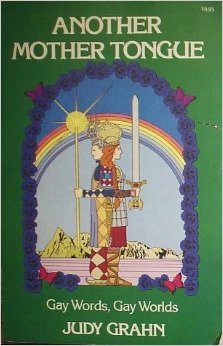 More recently, books from Judy Grahn, Andrew Harvey, Randy P. Connor and others have explored the spiritual connections between queer people and the spirit realms:
More recently, books from Judy Grahn, Andrew Harvey, Randy P. Connor and others have explored the spiritual connections between queer people and the spirit realms:
“In the long patriarchal history that has gradually enveloped the world’s people, the gay function has been to make crossover journeys between gender-worlds, translating, identifying and bringing back the information ……..gay culture is always on the cusp of each intersecting world or way of life, on the path between one world and another...
“The tribal attitude said, and continues to say, that Gay people are especially empowered because we are able to identify with both sexes and can see into more than one world at once, having the capacity to see from more than one point of view at a time.” Judy Grahn, Another Mother Tongue 1984
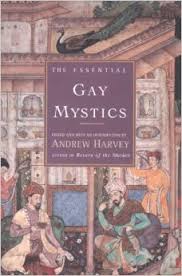 “Many shamans were and are homosexual; many of the worshipers of the Goddess under her various names and in her various cults all over the world – from the Mediterranean to the Near East to the Celtic parts of northern Europe – openly avowed their homosexuality and were accepted and even specially revered as priests, oracles, healers, and diviners. Homosexuals, far from being rejected, were seen as sacred – people who, by virtue of a mysterious fusion of feminine and masculine traits, participated with particular intensity in the life of the Source. The Source of Godhead is, after all, both masculine and feminine, and exists in a unity that includes but transcends both. The homosexual was thought to mirror this unity and its enigmatic fertility and power in a special way. The tribe or culture gave to him or her specific duties that were highly important and sacred, acknowledging this intimacy with divine truth and the clairvoyant help it could bring to the whole society.” Andrew Harvey, Gay Mystics (1998)
“Many shamans were and are homosexual; many of the worshipers of the Goddess under her various names and in her various cults all over the world – from the Mediterranean to the Near East to the Celtic parts of northern Europe – openly avowed their homosexuality and were accepted and even specially revered as priests, oracles, healers, and diviners. Homosexuals, far from being rejected, were seen as sacred – people who, by virtue of a mysterious fusion of feminine and masculine traits, participated with particular intensity in the life of the Source. The Source of Godhead is, after all, both masculine and feminine, and exists in a unity that includes but transcends both. The homosexual was thought to mirror this unity and its enigmatic fertility and power in a special way. The tribe or culture gave to him or her specific duties that were highly important and sacred, acknowledging this intimacy with divine truth and the clairvoyant help it could bring to the whole society.” Andrew Harvey, Gay Mystics (1998)
 Blossom of Bone, by Randy P Connor (1993) is a thorough and detailed study of the historical associations between gender-fluidity, same sex eroticism and the sacred, revealing vital queer presence in traditional shamanic cultures, ancient Goddess worship and the original cultures of the American continent. He wrote:
Blossom of Bone, by Randy P Connor (1993) is a thorough and detailed study of the historical associations between gender-fluidity, same sex eroticism and the sacred, revealing vital queer presence in traditional shamanic cultures, ancient Goddess worship and the original cultures of the American continent. He wrote:
“In the earliest spiritual traditions known to humankind, gender-variant, homoerotically or bisexually inclined persons served as shamans and priests of goddesses, gods, spirits and ancestors. With the so-called triumph of patriarchal, montheistic religions, these men were slaughtered or driven undergdound along with female shamans and priestesses.”
In ‘Two Spirit People: American Indian Lesbian Women and Gay Men’, Lester B Brown wrote, in 1997:
“American Indian cultures and societies have had and many presently have a variety of ways in which gender is expressed…. gender has not always been defined in dichotomies: boy/girl, man/woman. American Indian groups have at least six alternative gender styles: women and men, not-men (biological women who assume some aspects of male roles) and not-women (biological men who assume some aspects of female roles), lesbians and gays...
“Alternative gender roles were respected and honoured, and believed to be part of the sacred web of life and society…”
Mystical teacher Alan Watts said:
“Mythological images imply that holiness is hermaphroditic, for if holiness is wholeness the complete human being is at once male and female – the man who has developed his feminine aspect, and the woman her masculine. In Buddhist icongraphy, therefore, the Bodhisvatta is very frequently a hermaphrodite… the Bodhisattva Avalokiteshvara, who, though masculine in name, is always feminine or near-feminine in form, especially in the Far East, where he appears as Kwan-yin, or Kannon – the ‘goddess’ of mercy…. it is not uncommon to find ardhanari or ‘half-woman’ images of Shiva, in which the body is female on the left and male on the right.”
The repression of queer people is the suppression of nature herself.
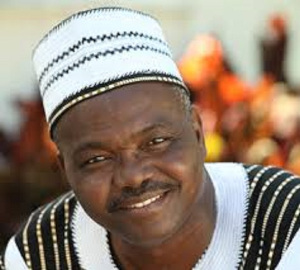 African wisdom teacher Malidoma Some of the Dagara tribe said, in 1993, that:
African wisdom teacher Malidoma Some of the Dagara tribe said, in 1993, that:
“The gay person is looked at primarily as a "gatekeeper." The Earth is looked at, from my tribal perspective, as a very, very delicate machine or consciousness, with high vibrational points, which certain people must be guardians of in order for the tribe to keep its continuity with the gods and with the spirits that dwell there. Spirits of this world and spirits of the other worlds. Any person who is at this link between this world and the other world experiences a state of vibrational consciousness which is far higher, and far different, from the one that a normal person would experience. This is what makes a gay person gay.”
He also said: “The modern world was built by Christianity. They have taken the gods out of the earth sent them to heaven, wherever that is. And everyone who aspires to the gods must then negotiate with Christianity, so that the real priests and priestesses are out of a job.”
This Imbolc, let's affirm the natural place of Queer people in the sacred web of life, and set our sights on reclaiming that place and discovering what it means for us today.
